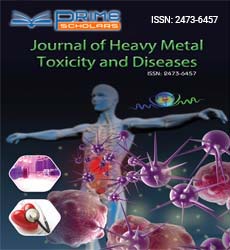Perspective - (2024) Volume 9, Issue 5
Long-Term Health Monitoring: The Crucial Role of Follow-Up Care for Individuals Exposed to Heavy Metals
Armando Castro*
Department of Health, University of Amsterdam, Netherlands
*Correspondence:
Armando Castro,
Department of Health, University of Amsterdam,
Netherlands,
Email:
Received: 01-Oct-2024, Manuscript No. ipjhmct-24-21859;
Editor assigned: 03-Oct-2024, Pre QC No. ipjhmct-24-21859 (PQ);
Reviewed: 17-Oct-2024, QC No. ipjhmct-24-21859;
Revised: 22-Oct-2024, Manuscript No. ipjhmct-24-21859 (R);
Published:
29-Oct-2024, DOI: 10.21767/2473-6457.24.5.46
Introduction
Heavy metal exposure is a pressing public health issue that can
lead to a myriad of health complications, ranging from acute
symptoms to chronic conditions. Metals such as lead, mercury,
arsenic, and cadmium can accumulate in the body, causing
lasting damage to vital organs and systems. While immediate
interventions, such as chelation therapy, can effectively reduce
heavy metal levels in the body, long-term health monitoring
is essential for ensuring the ongoing well-being of affected
individuals. This article explores the importance of follow-up
care for those exposed to heavy metals, highlighting its benefits,
challenges, and best practices.
Description
Heavy metals are naturally occurring elements that can be toxic
to humans and the environment at elevated levels. Common
sources of exposure include contaminated water, industrial
emissions, agricultural practices, and certain dietary choices. The
health effects of heavy metal exposure can be profound and wideranging.
Acute symptoms may include gastrointestinal distress,
neurological impairment, and respiratory issues, while chronic
exposure can lead to long-term health problems such as kidney
disease, cardiovascular issues, and developmental disorders.
One of the challenges of heavy metal toxicity is that symptoms
may not appear immediately. For example, lead exposure can
cause cognitive deficits that may not become evident until a
child reaches school age. Long-term health monitoring allows
for the early identification of such issues, facilitating timely
interventions. Individuals exposed to heavy metals are at
increased risk for chronic health conditions, including cancer,
neurodegenerative diseases, and cardiovascular disorders.
Regular follow-up care can help monitor for these conditions,
allowing for early detection and management. The stress of living
with heavy metal exposure can lead to anxiety and depression.
Long-term monitoring should include mental health assessments
to provide support and resources for affected individuals.
Genetic factors can influence how individuals metabolize and
respond to heavy metal exposure. Follow-up care should include
routine health assessments, which may involve blood tests, urine
analysis, and comprehensive physical examinations to monitor
for any signs of toxicity or related health issues. Based on the
type of heavy metal exposure, healthcare providers should
screen for specific conditions. For instance, individuals exposed
to lead may require cognitive assessments, while those exposed
to mercury may need evaluations for kidney function. Integrating
mental health support into follow-up care is vital. Screening for
anxiety, depression, and other psychological effects can provide
affected individuals with the necessary resources to cope with
their situation. Educating individuals about the potential longterm
effects of heavy metal exposure is crucial. Engaging with
community resources and support groups can provide additional
assistance for individuals and families affected by heavy metal
exposure. These programs can foster a sense of community
and help reduce feelings of isolation. Individuals in low-income
or underserved communities may face barriers to accessing
healthcare services, including follow-up care.
Conclusion
Long-term health monitoring is a critical component of care for
individuals exposed to heavy metals. By facilitating early detection
of health issues, providing mental health support, and promoting
patient education, follow-up care can significantly improve
health outcomes and quality of life for affected individuals.
While challenges remain, prioritizing long-term monitoring
initiatives can lead to better management of heavy metal toxicity
and a healthier future for vulnerable populations. Through
collaborative efforts among healthcare providers, policymakers,
and communities, we can ensure that those affected by heavy
metal exposure receive the comprehensive care they need to
thrive.
Citation: Castro A (2024) Long-term Health Monitoring: The Crucial Role of Follow-up Care for Individuals Exposed to Heavy Metals. J Heavy Met Toxicity Dis. 09:46.
Copyright: © 2024 Castro A. This is an open-access article distributed under the terms of the Creative Commons Attribution License, which permits unrestricted use, distribution, and reproduction in any medium, provided the original author and source are credited.

